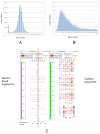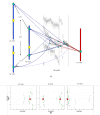A draft physical map of a D-genome cotton species (Gossypium raimondii)
- PMID: 20569427
- PMCID: PMC2996926
- DOI: 10.1186/1471-2164-11-395
A draft physical map of a D-genome cotton species (Gossypium raimondii)
Abstract
Background: Genetically anchored physical maps of large eukaryotic genomes have proven useful both for their intrinsic merit and as an adjunct to genome sequencing. Cultivated tetraploid cottons, Gossypium hirsutum and G. barbadense, share a common ancestor formed by a merger of the A and D genomes about 1-2 million years ago. Toward the long-term goal of characterizing the spectrum of diversity among cotton genomes, the worldwide cotton community has prioritized the D genome progenitor Gossypium raimondii for complete sequencing.
Results: A whole genome physical map of G. raimondii, the putative D genome ancestral species of tetraploid cottons was assembled, integrating genetically-anchored overgo hybridization probes, agarose based fingerprints and 'high information content fingerprinting' (HICF). A total of 13,662 BAC-end sequences and 2,828 DNA probes were used in genetically anchoring 1585 contigs to a cotton consensus genetic map, and 370 and 438 contigs, respectively to Arabidopsis thaliana (AT) and Vitis vinifera (VV) whole genome sequences.
Conclusion: Several lines of evidence suggest that the G. raimondii genome is comprised of two qualitatively different components. Much of the gene rich component is aligned to the Arabidopsis and Vitis vinifera genomes and shows promise for utilizing translational genomic approaches in understanding this important genome and its resident genes. The integrated genetic-physical map is of value both in assembling and validating a planned reference sequence.
Figures




Similar articles
-
Genomic tools development for Aquilegia: construction of a BAC-based physical map.BMC Genomics. 2010 Nov 8;11:621. doi: 10.1186/1471-2164-11-621. BMC Genomics. 2010. PMID: 21059242 Free PMC article.
-
An integrated genetic and physical map of homoeologous chromosomes 12 and 26 in Upland cotton (G. hirsutum L.).BMC Genomics. 2008 Feb 28;9:108. doi: 10.1186/1471-2164-9-108. BMC Genomics. 2008. PMID: 18307816 Free PMC article.
-
A preliminary analysis of genome structure and composition in Gossypium hirsutum.BMC Genomics. 2008 Jul 1;9:314. doi: 10.1186/1471-2164-9-314. BMC Genomics. 2008. PMID: 18590573 Free PMC article.
-
Comparative analysis of Gossypium and Vitis genomes indicates genome duplication specific to the Gossypium lineage.Genomics. 2011 May;97(5):313-20. doi: 10.1016/j.ygeno.2011.02.007. Epub 2011 Feb 22. Genomics. 2011. PMID: 21352905
-
Cotton2035: From genomics research to optimized breeding.Mol Plant. 2025 Feb 3;18(2):298-312. doi: 10.1016/j.molp.2025.01.010. Epub 2025 Jan 21. Mol Plant. 2025. PMID: 39844464 Review.
Cited by
-
cDNA-AFLP-based genetical genomics in cotton fibers.Theor Appl Genet. 2012 Mar;124(4):665-83. doi: 10.1007/s00122-011-1738-x. Epub 2011 Nov 13. Theor Appl Genet. 2012. PMID: 22080217
-
Genome-wide identification of auxin response factor (ARF) genes and its tissue-specific prominent expression in Gossypium raimondii.Funct Integr Genomics. 2015 Jul;15(4):481-93. doi: 10.1007/s10142-015-0437-0. Epub 2015 Mar 26. Funct Integr Genomics. 2015. PMID: 25809690
-
A sequence-ready physical map of barley anchored genetically by two million single-nucleotide polymorphisms.Plant Physiol. 2014 Jan;164(1):412-23. doi: 10.1104/pp.113.228213. Epub 2013 Nov 15. Plant Physiol. 2014. PMID: 24243933 Free PMC article.
-
Genome-Wide Survey and Comparative Analysis of Long Terminal Repeat (LTR) Retrotransposon Families in Four Gossypium Species.Sci Rep. 2018 Jun 20;8(1):9399. doi: 10.1038/s41598-018-27589-6. Sci Rep. 2018. PMID: 29925876 Free PMC article.
-
Characterization of the genome of bald cypress.BMC Genomics. 2011 Nov 11;12:553. doi: 10.1186/1471-2164-12-553. BMC Genomics. 2011. PMID: 22077969 Free PMC article.
References
-
- Wendel JF, Albert VA. Phylogenetics of the Cotton genus (Gossypium): Character-state weighted parsimony analysis of chloroplast-DNA restriction site data and its systematic and biogeographic implications. Systematic Botany. 1992;17:115–143. doi: 10.2307/2419069. - DOI
-
- Rong J, Abbey C, Bowers JE, Brubaker CL, Chang C, Chee PW, Delmonte TA, Ding X, Garza JJ, Marler BS. et al.A 3347-locus genetic recombination map of sequence-tagged sites reveals features of genome organization, transmission and evolution of cotton (Gossypium) Genetics. 2004;166:389–417. doi: 10.1534/genetics.166.1.389. - DOI - PMC - PubMed
Publication types
MeSH terms
Substances
LinkOut - more resources
Full Text Sources

